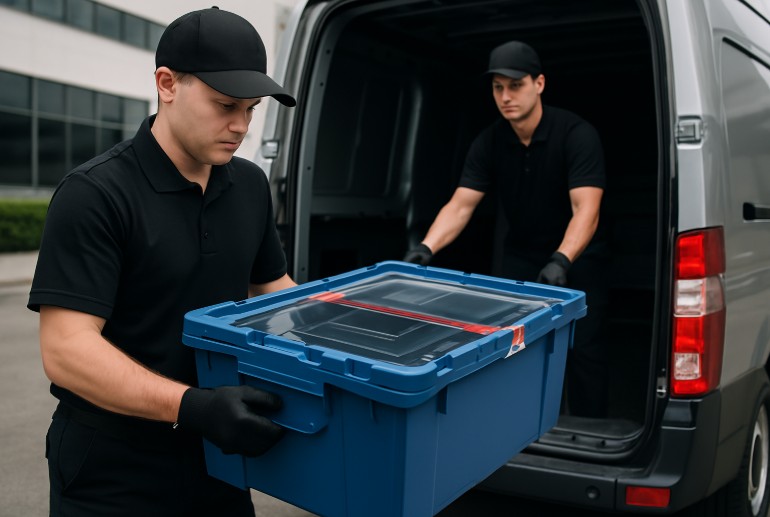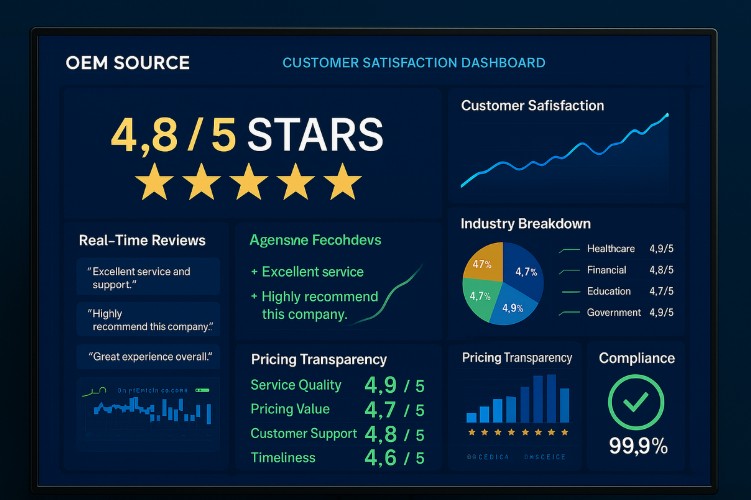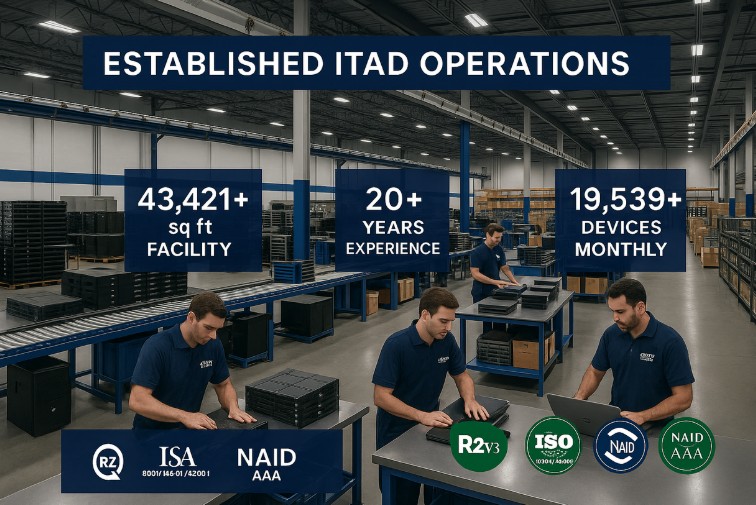In today’s data-centric world, securely disposing of IT assets is a critical aspect of corporate governance and risk management. As technology lifecycles shorten, businesses are retiring a growing volume of computers, servers, and data-bearing devices. While final data destruction methods, such as shredding or degaussing, are essential, the transportation of these assets from the point of decommissioning to the destruction facility introduces some of the greatest security vulnerabilities.
Secure logistics—including proper packaging, tracking, and controlled transportation protocols—is an indispensable link in the chain of custody. Lapses during transit can lead to data breaches, regulatory non-compliance with privacy laws, financial penalties, and severe reputational harm.
This article outlines best practices for secure logistics in data destruction, detailing crucial steps for organizations must implement before, during, and after IT asset transportation. From detailed inventory management and tamper-evident packaging to GPS tracking and secure handoff protocols, a robust logistics strategy is vital for safeguarding sensitive information until its verified destruction.
The Critical Role of Secure Logistics in Data Destruction
The journey of an IT asset to its final destruction is a phase often overlooked in data security. While organizations invest heavily in cybersecurity during an asset’s active life and in destruction techniques at its end, the interim transportation period remains a critical blind spot.
Secure logistics in data destruction refers to specialized processes that protect data-bearing IT assets from unauthorized access, theft, or damage during physical movement. This isn’t standard shipping—it requires heightened security for highly sensitive cargo. Its primary function is to maintain an unbroken chain of custody and data integrity from decommissioning until verified destruction.
Without robust security in transit, even the most advanced destruction methods are compromised. Such a breach can expose confidential corporate data, customer Personally Identifiable Information (PII), or Protected Health Information (PHI). These consequences can be severe: regulatory fines under GDPR, HIPAA, or CCPA, financial losses, and irreparable reputational damage.
Many compliance frameworks explicitly require organizations to safeguard data throughout its lifecycle, including transit for disposal. Thus, secure logistics is a fundamental compliance requirement, underpinning an effective IT Asset Disposition (ITAD) program.
Stringent logistical controls mitigate risks, safeguard information, ensure compliance, and preserve stakeholder confidence.
Pre-Transport Best Practices: Preparing Assets for Secure Transit
Effective security during IT asset transportation starts long before assets leave the premises. Meticulous pre-transport preparation is essential for minimizing risks and ensuring a secure journey.
- Establish a detailed asset inventory:
Start by creating a comprehensive inventory of assets for disposal, including type, serial number, asset tag, make, model, and location. This record serves as the foundation for the chain of custody and reconciliation. Address any discrepancies prior to transport to prevent delays or gaps in tracking. - Use secure, tamper-evident packaging:
All assets must be securely packaged to prevent damage and unauthorized access. Use tamper-evident bags or containers for loose hard drives or small media, sealed to make tampering obvious. For larger equipment, use secure, lockable containers or pallets with opaque, tamper-evident shrink wrap, also protecting against environmental factors. - Remove and manage removable media separately:
If media sanitization is not being performed on-site, remove peripheral removable media (USB drives, CDs) and inventory or destroy them separately. - Label for control, not visibility:
Each container or asset should be labeled clearly but discreetly, using coded labels aligned with the inventory to avoid undue attention. - Coordinate with your ITAD provider:
Work closely with your ITAD vendor on pickup schedules, approved personnel, and pre-transport requirements. Verify the collection team’s identity and complete all documentation before asset release.
Well-executed pre-transport practices significantly reduce data exposure or asset loss risks, setting the stage for a secure end-to-end disposition.
Best Practices During Transit: Ensuring Security on the Move
Once IT assets are packaged for disposal, maintaining their security throughout the transportation phase is crucial. This stage demands a combination of physical security, technological tracking, and procedural diligence.
- Use dedicated, secure vehicles:
Employ specialized transport vehicles with reinforced cargo areas, robust locks, and no external markings indicating sensitive cargo. - Implement GPS tracking and geofencing:
Real-time GPS vehicle tracking is essential for monitoring asset movement. Use systems that support geofencing, alerting you of route deviations or unscheduled stops. - Ensure dual custody during transport:
Whenever possible, require that two security-cleared individuals accompany the vehicle, especially for high-value shipments. - Plan direct, minimal-transfer routes:
Use direct routing, minimizing stops and transfers. Plan and adhere to the most direct route. - Maintain a continuous, unbroken chain of custody:
Document all transfers of responsibility with signatures and timestamps. - Secure temporary storage conditions (if required):
If assets are temporarily stored, control and log access strictly. - Define clear communication protocols:
Ensure regular check-ins between the transport team and the operations center. Implement incident reporting procedures in case of emergencies or route deviations. - Add physical transport seals:
Use tamper-evident seals on vehicle doors, besides those on packages, for an extra security layer. - Prepare for contingencies:
Have a contingency plan for unforeseen events (breakdowns, accidents, security threats), including procedures for securing assets and notifying relevant parties.
Rigorous application of these practices significantly reduces data breach risks, ensuring assets arrive securely for destruction.
Post-Transport Best Practices: Secure Handoff and Verification
Secure IT asset handling doesn’t end upon arrival at the destruction facility. The post-transport phase, with secure handoff and meticulous verification, is critical for maintaining chain of custody integrity and accounting for all assets before destruction.
- Inspect and verify shipment integrity:
Upon arrival, verify shipment integrity by inspecting all tamper-evident seals on the vehicle and packages. Document and report any tampering, damage, or discrepancies immediately. - Secure unloading procedures:
Unload assets carefully in a secure, access-controlled receiving area under surveillance, restricted to authorized personnel. - Reconcile received assets with inventory records:
Carefully match each unloaded asset against the original pre-transport inventory list, checking each asset tag and serial number. This confirms all dispatched assets arrived safely. Investigate and resolve any discrepancies before data destruction. - Document the formal handoff:
Once verified, formally hand off custody to facility personnel, documented with signatures, dates, and times from both teams. A copy of the signed record should be provided to the client. - Secure interim storage (if required):
Following handoff, move assets to secure, segregated storage if not processed immediately, with strictly controlled and logged access. - Final verification before destruction:
Before any destruction begins, perform a final asset verification against the destruction order, ensuring only designated assets are destroyed using correct methods per policy.
Adhering to these post-transport practices ensures a secure, verifiable conclusion to logistics, supporting subsequent destruction and certification, and reinforcing ITAD program security.
Choosing a Secure Logistics Partner for IT Asset Disposition
Selecting the right partner for secure IT asset transport and disposition critically impacts data security, compliance, and reputation. Not all ITAD vendors offer equal security or expertise, so thorough due diligence is essential.
Certifications and regulatory alignment:
Start by verifying the provider holds relevant third-party certifications, such as R2 or NAID AAA Certification. These demonstrate a commitment to best practices for environmental responsibility, data security, and worker safety. Additionally, verify their understanding of regulations like GDPR, HIPAA, and state e-waste laws. The ability to articulate how their practices support compliance with these frameworks is critical.
Secure transportation protocols:
Evaluate the vendor’s documented transport security measures. Inquire about vehicle security (GPS, secure locks, unmarked vehicles), driver screening and training, chain of custody, and incident response. Do they use dedicated vehicles and security-cleared personnel? Can they provide real-time tracking?
Destruction capabilities and audit trail:
The provider should offer certified data destruction methods that align with recognized standards, such as NIST 800-88 wiping, degaussing, or shredding, with auditable Certificates of Destruction.
Transparency, documentation, and reporting:
A trustworthy vendor offers transparent processes, allows audits, and provides comprehensive reporting. This includes:
- Inventory reconciliation reports
- Chain of custody logs
- Destruction and recycling certificates
Reputation and insurance coverage:
Consider their industry experience and reputation through references and case studies. Also, confirm their insurance.
By carefully evaluating these criteria, you can confidently select an ITAD partner who meets compliance obligations and acts as a trusted extension of your data security efforts, ensuring responsible and secure end-of-life asset management.
Regulatory Landscape and Compliance in IT Asset Transportation
IT asset transportation for data destruction is governed by a complex and evolving network of regulations designed to protect sensitive data and the environment. Adhering to these regulations and industry requirements is essential for avoiding penalties and maintaining full compliance.
Data protection laws—including GDPR, HIPAA, and CCPA/CPRA—mandate appropriate technical and organizational measures for personal data security throughout its lifecycle, including transit for destruction. Failure to secure assets in transit can be a data breach, leading to fines and legal action.
Environmental regulations—such as Resource Conservation and Recovery Act (RCRA) in the U.S. and the WEEE Directive in the E.U.—govern the handling, transport, and disposal of electronic waste. These frameworks often include secure transport provisions to prevent illicit dumping, contamination, or improper disposal of hazardous components.
Industry-specific regulations add further complexity:
- Gramm-Leach-Bliley Act (GLBA) for finance
- Health Insurance Portability and Accountability Act (HIPAA) for healthcare
R2 standards, while voluntary, are increasingly expected and set specific requirements for secure transport and chain of custody.
Compliance requires understanding applicable laws and standards, implementing robust internal policies, thorough due diligence on third-party providers, and meticulous documentation. Proactive engagement with these requirements is essential for avoiding legal issues and demonstrating responsible data stewardship.
How OEM Source Ensures Secure Logistics for Your IT Assets
At OEM Source, we understand that your IT assets’ transit security is as critical as their final destruction. We integrate robust, secure logistics into our comprehensive ITAD services, providing clients peace of mind and demonstrable compliance.
Our approach is built on meticulous planning, stringent security protocols, and transparent chain of custody. When you partner with OEM Source for ITAD, you gain a tailored logistics plan addressing your specific security and operational needs.
This begins with detailed pre-pickup inventorying to ensure full asset accountability from the start. Our secure data deletion services can even begin pre-transport, offering on-site wiping or degaussing for added protection of sensitive information before equipment ever leaves your facility.
For transported assets, we use vetted partners adhering to strict security: secure vehicles, trained personnel, documented chain of custody, and tamper-evident packaging.
Upon arrival at one of our R2-certified downstream partner facilities, assets are received in secure, access-controlled areas and reconciled against inventory records to ensure integrity and prevent loss or mishandling.
OEM Source provides comprehensive documentation: asset tracking reports and certificates of data destruction, offering a clear audit trail. Additionally, our reclaim and recycle services are secure and environmentally responsible.
Choosing OEM Source. means selecting a partner dedicated to protecting your sensitive data at every stage, including transit. We help you navigate the complexities of ITAD with secure, compliant solutions aligned with your business objectives.
Frequently Asked Questions: Transporting IT Assets
What is secure logistics in IT asset data destruction?
Secure logistics refers to the specialized processes, protocols, and physical security measures used to protect data-bearing IT assets during transportation to a secure data destruction facility. It includes detailed inventorying, tamper-evident packaging, secure vehicles with GPS tracking, vetted personnel, and a documented chain of custody. These measures prevent unauthorized access, loss, or tampering while ensuring full accountability, making secure logistics a critical part of any comprehensive ITAD program.
Why is secure IT asset transportation vital before data destruction?
Secure transportation is crucial as decommissioned IT assets often still contain sensitive data. If compromised during transit—due to theft, loss, or unauthorized access—organizations may face regulatory penalties (e.g., under GDPR, HIPAA), financial losses, and lasting reputational damage. Secure transportation ensures assets remain protected until verified destruction occurs, closing a key vulnerability in the ITAD process.
What are the key pre-transport best practices for IT assets?
Key pre-transport best practices include creating a detailed inventory of all assets (serial numbers, asset tags), using tamper-evident packaging, removing peripheral removable media, labeling packages discreetly, and coordinating closely with your ITAD vendor for pickup, including verifying the collection team’s identity.
These steps establish a clear chain of custody from the start.
What security measures are needed during IT asset transit?
During transit, security measures should include dedicated, secure vehicles (unmarked, GPS tracked), security-cleared personnel (ideally two per vehicle), direct routing, continuous chain of custody documentation, tamper-evident seals on vehicle doors, and clear communication protocols. Contingency plans for unexpected events are also essential for maintaining security on the move.
How can I ensure my ITAD partner provides secure logistics?
When selecting an ITAD partner like OEM Source, look for certifications such as R2. Inquire about their specific transportation security protocols, vehicle security, personnel screening, chain of custody procedures, and their ability to provide auditable documentation, including Certificates of Data Destruction. Reputable vendors, familiar with guidelines from bodies like NIST, will be transparent about their processes.





